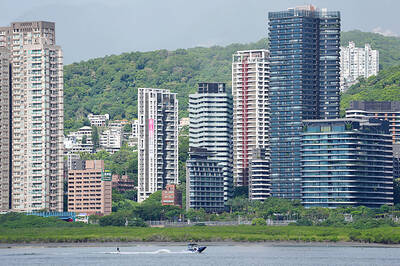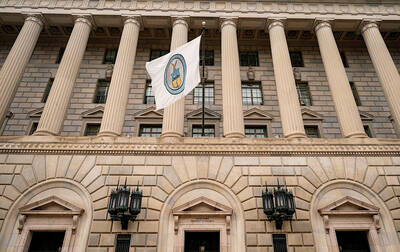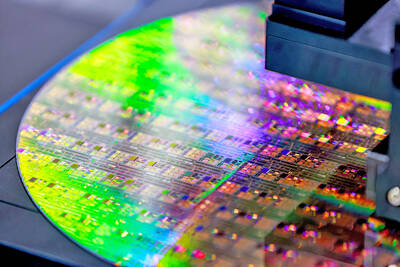The central bank’s quarterly balance-of-payments report on Friday showed that current-account surplus tumbled 27.3 percent from a year earlier to US$18.65 billion in the fourth quarter last year, as net exports sank sharply.
The current account, calculating a nation’s transactions with foreign countries, mainly reflects the trade balance in merchandise and services.
Net exports — exports minus imports — shrank 24 percent from a year earlier to US$17.47 billion, as the US$800 million decline in imports was less than the US$6.25 billion plunge in exports, the central bank said, adding that it was due to slowing global demand and lackluster growth in the smartphone market.
For the whole of last year, exports rose 1 percent annually to US$353.45 billion and imports gained 6.2 percent to US$285.71 billion, resulting in a trade surplus of US$67.73 billion, down 16.2 percent from 2017, central bank data showed.
“The increase in imports reflects the increases in crude purchases in the second and third quarters because of favorable prices, as well as more purchases of machinery equipment in the third quarter for new investments,” Eugene Tsai (蔡炯民), deputy director-general of the central bank’s Department of Economic Research, said at a news conference in Taipei.
With the trade surplus declining, the current-account surplus totaled US$68.26 billion last year, down US$14.58 billion from 2017 and the lowest in four years since the US$60.44 billion surplus in 2014, the central bank said.
However, the service trade balance, the second-biggest component of the current account, last quarter improved on travel revenue, with the service trade deficit narrowing 48.34 percent quarterly to US$780 million, it said.
That helped the full-year service trade deficit contract 21.4 percent annually to US$6.82 billion, the data showed.
The report also showed a deficit of US$17.88 billion in financial account for last quarter, indicating net capital outflows.
Last quarter's financial account deficit was down 17.9 percent from the US$21.78 billion a year earlier, the data showed.
Local banks’ short-term net borrowing of US$4.3 billion from their foreign peers last quarter, compared with their net lending of US$6.5 billion a year earlier, contributed to the decline in the financial account deficit, the data showed.
Last quarter was the 34th consecutive quarter that the financial account had posted a net outflow, the longest on record, and brought the total deficit to US$51.92 billion for the whole of last year, the central bank said.
Aggregate net outflows over the past 34 quarters totaled US$413.31 billion, it said.
Separately, overseas securities held by Taiwanese last quarter fell 16.4 percent annually, as domestic life insurers bought less foreign equities amid foreign-exchange volatility.
Foreign portfolio managers reduced their local share holdings by US$3.11 billion as the TAIEX fell sharply over the period, Tsai said.
For the whole of last year, foreign portfolio managers cut local share holdings by US$11.9 billion, a seven-year high, compared with a net increase of US$3.89 billion a year earlier, the data showed.

Taiwan’s rapidly aging population is fueling a sharp increase in homes occupied solely by elderly people, a trend that is reshaping the nation’s housing market and social fabric, real-estate brokers said yesterday. About 850,000 residences were occupied by elderly people in the first quarter, including 655,000 that housed only one resident, the Ministry of the Interior said. The figures have nearly doubled from a decade earlier, Great Home Realty Co (大家房屋) said, as people aged 65 and older now make up 20.8 percent of the population. “The so-called silver tsunami represents more than just a demographic shift — it could fundamentally redefine the

The US government on Wednesday sanctioned more than two dozen companies in China, Turkey and the United Arab Emirates, including offshoots of a US chip firm, accusing the businesses of providing illicit support to Iran’s military or proxies. The US Department of Commerce included two subsidiaries of US-based chip distributor Arrow Electronics Inc (艾睿電子) on its so-called entity list published on the federal register for facilitating purchases by Iran’s proxies of US tech. Arrow spokesman John Hourigan said that the subsidiaries have been operating in full compliance with US export control regulations and his company is discussing with the US Bureau of

Businesses across the global semiconductor supply chain are bracing themselves for disruptions from an escalating trade war, after China imposed curbs on rare earth mineral exports and the US responded with additional tariffs and restrictions on software sales to the Asian nation. China’s restrictions, the most targeted move yet to limit supplies of rare earth materials, represent the first major attempt by Beijing to exercise long-arm jurisdiction over foreign companies to target the semiconductor industry, threatening to stall the chips powering the artificial intelligence (AI) boom. They prompted US President Donald Trump on Friday to announce that he would impose an additional

Pegatron Corp (和碩), a key assembler of Apple Inc’s iPhones, on Thursday reported a 12.3 percent year-on-year decline in revenue for last quarter to NT$257.86 billion (US$8.44 billion), but it expects revenue to improve in the second half on traditional holiday demand. The fourth quarter is usually the peak season for its communications products, a company official said on condition of anonymity. As Apple released its new iPhone 17 series early last month, sales in the communications segment rose sequentially last month, the official said. Shipments to Apple have been stable and in line with earlier expectations, they said. Pegatron shipped 2.4 million notebook